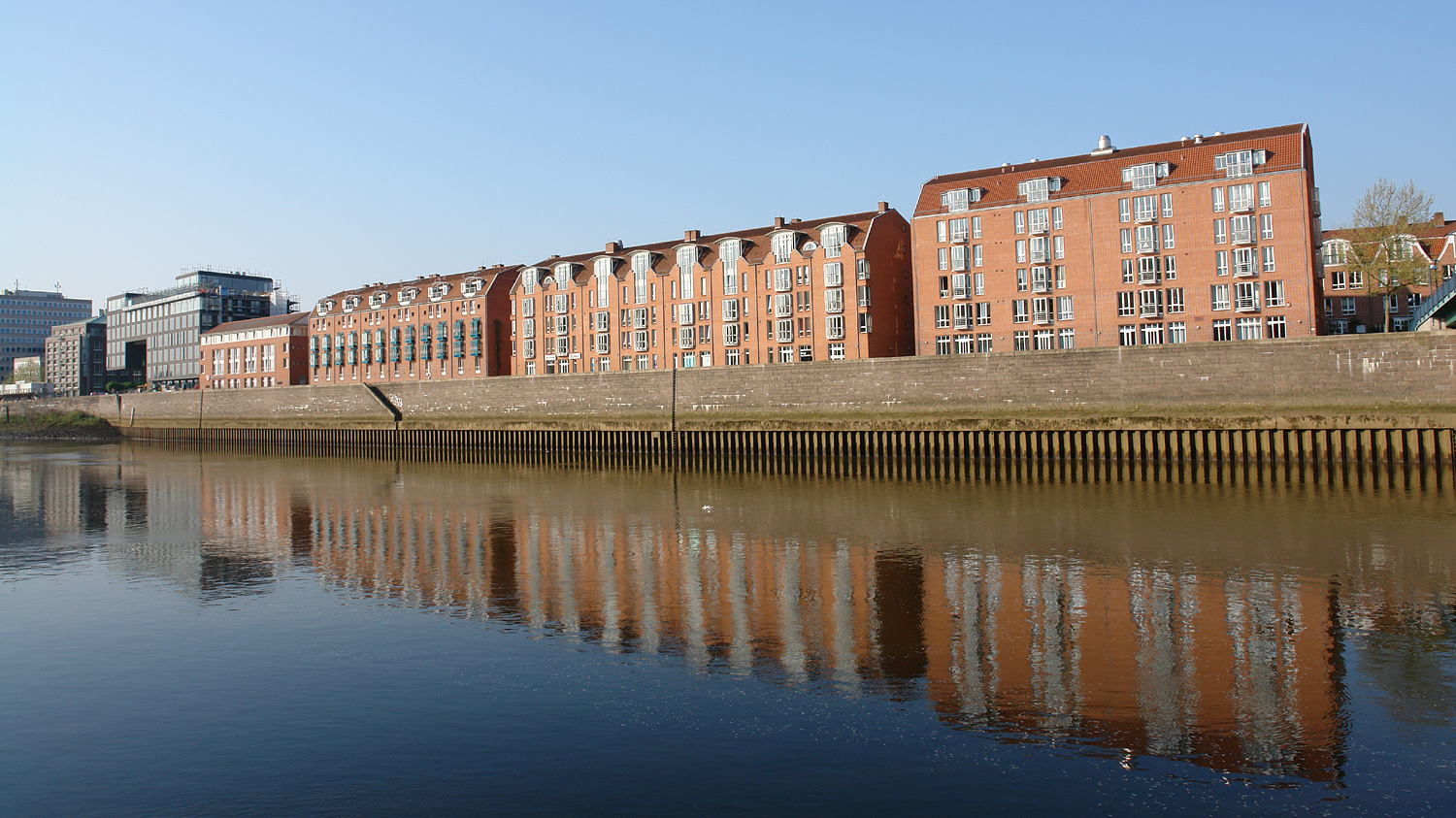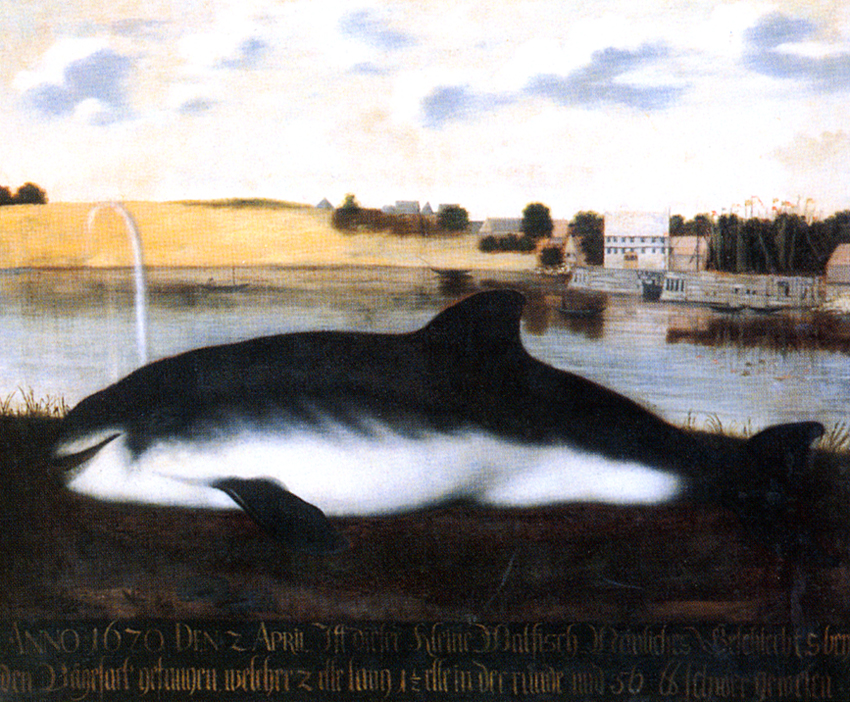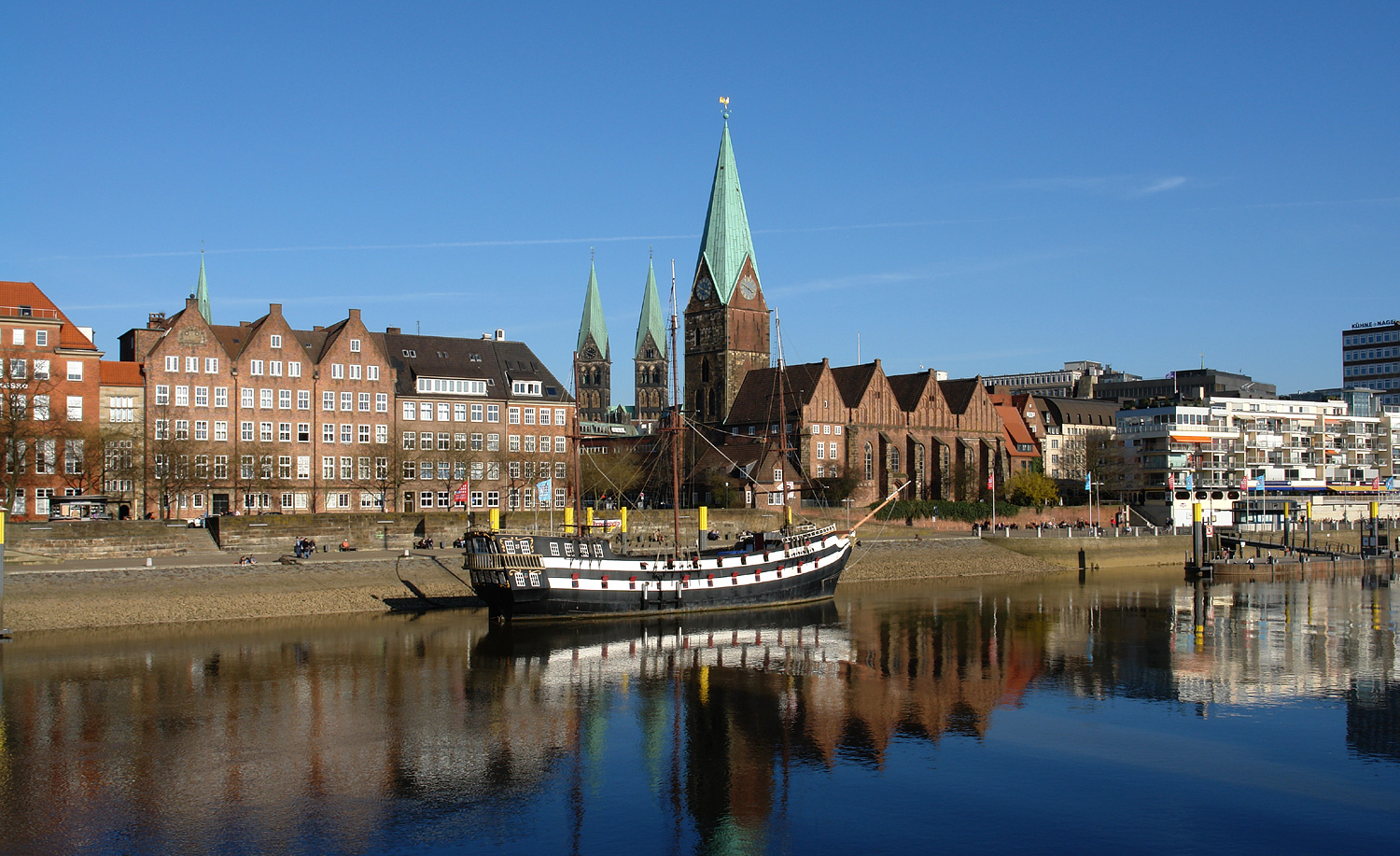|
Jacob Ephraim Polzin
Jacob Ephraim Polzin (1778 – 18 November 1851) was a German Neoclassical architect active in Bremen, Germany. Life Son of a master carpenter, Polzin was born in Königsberg in 1778. He trained in Copenhagen and quickly found work for three years helping to construct the new Christiansborg Palace which Christian Frederik Hansen had designed. In 1811 he moved to Bremen where he married the daughter of the local master carpenter in 1814. Polzin had worked on re-designing the town's marketplace notwithstanding the French occupation. He also worked on houses in the Schlachte and what was then the river island of Teerhof. The houses on the Teerhof were largely destroyed by bombing during the second world war. Polzin's work at that time was said to be influenced by Karl Friedrich Schinkel. Polzin worked on the creation of the new street and buildings which were created as the town walls were abandoned. The new street was named Am Wall and several of Polzin's designs are still standi ... [...More Info...] [...Related Items...] OR: [Wikipedia] [Google] [Baidu] |
Rudolph Suhrlandt
Rudolph Friedrich Carl Suhrlandt (19 December 1781, in Ludwigslust – 2 February 1862, in Schwerin) was a German portrait painter and lithographer. Biography His father, Johann Heinrich Suhrlandt, was a court painter for Grand Duke Fredrick Francis I of Mecklenburg. His first art lessons came from his father. In 1799, he became a student at the Dresden Academy of Fine Arts, with a royal scholarship and a recommendation from Christian Daniel Rauch. His teachers there included Johann Eleazar Zeissig and Josef Grassi. Hela Baudis: ''Rudolph Suhrlandt (1781–1862). Grenzgänger zwischen Klassizismus und Biedermeier. Leben und Werk eines deutschen Hofmalers und Porträtisten des Bürgertums''. Diss. Greifswald 2008Digitalized In 1803, he moved to Vienna to take classes at the Academy of Fine Arts with Heinrich Füger. There, he acquainted himself with the writings of Johann Joachim Winckelmann on Classical art and came under the influence of Antonio Canova. He also established h ... [...More Info...] [...Related Items...] OR: [Wikipedia] [Google] [Baidu] |
Teerhof
The Teerhof is a peninsula between the River Weser and the Kleine Weser, opposite the city centre of Bremen, Germany. It was first mentioned in 1624 as "Theerhof" when it was the northernmost part of an island. Today it consists mainly of residential buildings and the Weserburg modern art museum. History The name Teerhof means "tarring yard" as it was here ship hulls and ropes were once tarred for the local shipyard. Up to the end of the 19th century, mixed industrial and residential developments led to a widely varying collection of buildings. By the 1930s, the Teerhof was made up of storehouses, small production facilities, a coffee factory and housing. All the buildings were almost completely destroyed during the Second World War. The Weserburg coffee factory which was also seriously damaged was repaired and reopened in 1949. When it closed in 1973, the building was sold to the city and was used for various cultural events including artists' ateliers and art exhibitions, unti ... [...More Info...] [...Related Items...] OR: [Wikipedia] [Google] [Baidu] |
Architects From Königsberg
An architect is a person who plans, designs and oversees the construction of buildings. To practice architecture means to provide services in connection with the design of buildings and the space within the site surrounding the buildings that have human occupancy or use as their principal purpose. Etymologically, the term architect derives from the Latin ''architectus'', which derives from the Greek (''arkhi-'', chief + ''tekton'', builder), i.e., chief builder. The professional requirements for architects vary from place to place. An architect's decisions affect public safety, and thus the architect must undergo specialized training consisting of advanced education and a ''practicum'' (or internship) for practical experience to earn a license to practice architecture. Practical, technical, and academic requirements for becoming an architect vary by jurisdiction, though the formal study of architecture in academic institutions has played a pivotal role in the development of the ... [...More Info...] [...Related Items...] OR: [Wikipedia] [Google] [Baidu] |
1851 Deaths
Events January–March * January 11 – Hong Xiuquan officially begins the Taiping Rebellion. * January 15 – Christian Female College, modern-day Columbia College, receives its charter from the Missouri General Assembly. * January 23 – The flip of a coin, subsequently named Portland Penny, determines whether a new city in the Oregon Territory is named after Boston, Massachusetts, or Portland, Maine, with Portland winning. * January 28 – Northwestern University is founded in Illinois. * February 1 – ''Brandtaucher'', the oldest surviving submersible craft, sinks during acceptance trials in the German port of Kiel, but the designer, Wilhelm Bauer, and the two crew escape successfully. * February 6 – Black Thursday in Australia: Bushfires sweep across the state of Victoria, burning about a quarter of its area. * February 12 – Edward Hargraves claims to have found gold in Australia. * February 15 – In Boston, Massac ... [...More Info...] [...Related Items...] OR: [Wikipedia] [Google] [Baidu] |
1778 Births
Events January–March * January 18 – Third voyage of James Cook: Captain James Cook, with ships HMS ''Resolution'' and HMS ''Discovery'', first views Oahu then Kauai in the Hawaiian Islands of the Pacific Ocean, which he names the ''Sandwich Islands''. * February 5 – **South Carolina becomes the first state to ratify the Articles of Confederation. ** **General John Cadwalader shoots and seriously wounds Major General Thomas Conway in a duel after a dispute between the two officers over Conway's continued criticism of General George Washington's leadership of the Continental Army.''Harper's Encyclopaedia of United States History from 458 A. D. to 1909'', ed. by Benson John Lossing and, Woodrow Wilson (Harper & Brothers, 1910) p166 * February 6 – American Revolutionary War – In Paris, the Treaty of Alliance and the Treaty of Amity and Commerce are signed by the United States and France, signaling official French recognition of the new rep ... [...More Info...] [...Related Items...] OR: [Wikipedia] [Google] [Baidu] |
Domshof
The Domshof (''Cathedral Court'') is a town square in Bremen, north of the Bremen Cathedral, cathedral and the Bremer Marktplatz, Marktplatz. The Domshof is used for markets as well as larger outdoor events, particularly May Day demonstrations. The Domshof is a trapezoid in width, long on the western side and long on the eastern side. Several streets radiate off the square (Schüsselkorb, Violenstraße, Seemannstraße, Sandstraße, Unser-Lieben-Frauen-Kirchhof and the Dompassage). Buildings on the square include Bremen Cathedral, the Town Hall of Bremen, Bremen Landesbank, the Deutsche Bank am Domshof, Skandinaviska Enskilda Banken, SEB Bank (formerly Bank für Gemeinwirtschaft, BfG), the Schifffahrtsbank and the Bremer Bank. The buildings around the Domshof are relatively uniform in construction, being made of sandstone (e.g. Bremer Bank) and dark red or Clinker brick, clinker brick (e.g. the town hall and the Landesbank). The red Maintal sandstone of the Deutsche Bank and a w ... [...More Info...] [...Related Items...] OR: [Wikipedia] [Google] [Baidu] |
Vegesack
Vegesack is a northern district of the city of Bremen. Geography ''Vegesack'' is located about north from the centre of Bremen-city at the mouth of the river Lesum, beside the river Weser (). Abutting the district of Vegesack to the northwest is the district of Blumenthal, in the southeast the district of Burglesum. Across the river Weser is the Lower Saxony village Lemwerder, connected to Vegesack by a ferry service. History Vegesack was established long before the 14th century. At that time the mouth of the river Lesum and the small brook Aue to the river Weser was a preferred and protected berth for sailing ships in the winter time or in the stormy seasons. Therefore, the first buildings might have been a few workshops and accommodations and pubs for the sailors. After the first mention of a ferry across the Weser in the 14th century, the name "Vegesack" was first used in 1453. The source and the meaning of the name is unknown but might be derived from the pub "Thom Fege ... [...More Info...] [...Related Items...] OR: [Wikipedia] [Google] [Baidu] |
Am Wall
AM or Am may refer to: Arts and entertainment Music * A minor, a minor scale in music * ''A.M.'' (Chris Young album) * ''A.M.'' (Wilco album) * ''AM'' (Abraham Mateo album) * ''AM'' (Arctic Monkeys album) * AM (musician), American musician * Am, the A minor chord symbol * ''Armeemarschsammlung'' (Army March Collection), catalog of German military march music * Andrew Moore (musician), Canadian musician known as A.M. * DJ AM, American DJ and producer * Skengdo & AM, British hip hop duo Television and radio * ''AM'' (ABC Radio), Australian current affairs radio program * ''American Morning'', American morning television news program * ''Am, Antes del Mediodía'', Argentine current affairs television program * Am, a character in the anthology '' Star Wars: Visions'' Other media * Allied Mastercomputer, the antagonist of the short story "I Have No Mouth, and I Must Scream" Education * Active Minds, a mental health awareness charity * Arts et Métiers ParisTech, a French e ... [...More Info...] [...Related Items...] OR: [Wikipedia] [Google] [Baidu] |
Karl Friedrich Schinkel
Karl Friedrich Schinkel (13 March 1781 – 9 October 1841) was a Prussian architect, city planner and painter who also designed furniture and stage sets. Schinkel was one of the most prominent architects of Germany and designed both neoclassical and neogothic buildings. His most famous buildings are found in and around Berlin. Biography Schinkel was born in Neuruppin, Margraviate of Brandenburg. When he was six, his father died in the disastrous Neuruppin fire of 1787. He became a student of architect Friedrich Gilly (1772–1800) (the two became close friends) and his father, David Gilly, in Berlin. At that time, the architectural taste in Prussia was shaped in neoclassical style, mainly by Carl Gotthard Langhans, the architect of the Brandenburg Gate in Berlin. After returning to Berlin from his first trip to Italy in 1805, he started to earn his living as a painter. When he saw Caspar David Friedrich's painting ''Wanderer above the Sea of Fog'' at the 1810 Berlin art ... [...More Info...] [...Related Items...] OR: [Wikipedia] [Google] [Baidu] |
Schlachte
The Schlachte is a promenade along the east bank of the River Weser in the old town of Bremen in the north of Germany. Once one of the city's harbours, it is now popular for its restaurants, beer gardens and river boats. Etymology ''Schlachte'' is a Low German word for a river bank reinforced with wooden piles driven in by the action of hammering (cf. German ''eingeschlagenen''). The word ''slait'' was used as early as 1250 to refer to the river bank in Bremen. History In 1247, following authorisation from Archbishop Gerhard II, the area between St Martini's Church and Zweite Schlachtpforte (a street meaning "second quayside gate") was settled by local citizens and traders. In 1250, those privileged to operate water mills were required to maintain the wooden piles used to reinforce the river bank. In the 13th century, both the Schlachte and the Balge were used as harbours for wood (used as firewood) and limestone although the banks of the Balge soon became Bremen's main port. Bo ... [...More Info...] [...Related Items...] OR: [Wikipedia] [Google] [Baidu] |
Königsberg
Königsberg (, ) was the historic Prussian city that is now Kaliningrad, Russia. Königsberg was founded in 1255 on the site of the ancient Old Prussian settlement ''Twangste'' by the Teutonic Knights during the Northern Crusades, and was named in honour of King Ottokar II of Bohemia. A Baltic port city, it successively became the capital of the Królewiec Voivodeship, the State of the Teutonic Order, the Duchy of Prussia and the provinces of East Prussia and Prussia. Königsberg remained the coronation city of the Prussian monarchy, though the capital was moved to Berlin in 1701. Between the thirteenth and the twentieth centuries, the inhabitants spoke predominantly German, but the multicultural city also had a profound influence upon the Lithuanian and Polish cultures. The city was a publishing center of Lutheran literature, including the first Polish translation of the New Testament, printed in the city in 1551, the first book in Lithuanian and the first Lutheran catechism, ... [...More Info...] [...Related Items...] OR: [Wikipedia] [Google] [Baidu] |
Bremer Marktplatz
The Bremer Marktplatz (Bremen Market Square) is a square situated in the centre of the Hanseatic City of Bremen. One of the oldest public squares in the city, it covers an area of . It is no longer used as a market place except for the Christmas market and the annual Freimarkt Fair at the end of October. History and development At least parts of the market place had been in function since the age of Charlemagne. Its southern side originally was the bank of river Balge (river), a branch of the Weser and Bremen's first port. There was an easy access for boats, but this section of the bank was too low for permanent buildings. From late 12th to late 13th century, the area of the market place was levelled and plastered in several stages. Theories that before the construction of the Bremen Town Hall in 1405 to 1410 all or only most of the market activities took place near Liebfrauenkirche have been falsified by archeological findings. Meantime with the townhall, Roland Statue ... [...More Info...] [...Related Items...] OR: [Wikipedia] [Google] [Baidu] |








.jpg)
